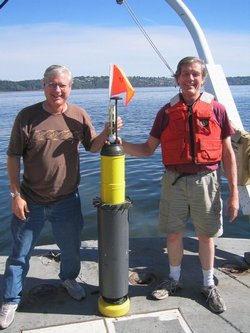
Photo: U of Washington Applied Physics Laboratory. Senior electrical engineers Jim Carlson and John Dunlap with the EM-APEX float.
The floats, manufactured by Webb Research Corporation and called Electromagnetic-Autonomous Profiling Explorers (EM-APEXs) with instrumentation designed and built at APL, measure the ocean's velocity electromagnetically, and monitor water temperature and salinity, with excursions to depths of 500 meters every 16 hours. Each made more than 100 up-and-down profiles, mostly while under water, and then tranferred back the data they had collected over the Iridium satellite cell phone system, using Columbia University's Embedded Kermit (E-Kermit), which had been embedded in the float's control processor by APL Senior Electrical Engineer John Dunlap (pictured on the right, with float), a longtime Kermit Project contributor, who is leaving Thursday (September 23rd) on a cruise to collect the floats, describes Kermit's role in the project: